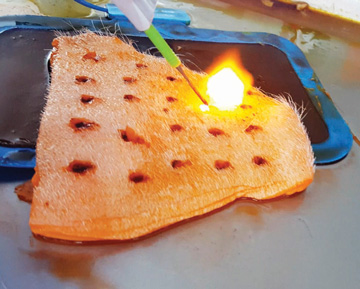Electrosurgical devices are used in virtually every operating room across the country, so it’s worrisome that surgeons and surgical teams don’t receive formal training on how the technology works — especially when even a minor mishap can result in significant patient burns and life-threatening fires. The responsibility lies with everyone in the OR to make sure electrosurgery instruments are used correctly and cared for properly. Surgical teams who understand the patterns of complications that occur with these instruments will be able to break the cycle of avoidable patient harm.
- Home
- Article
Protect Patients During Electrosurgery
By: Thomas Robinson, MD, MS, FACS
Published: 11/22/2022
Educate yourself on how to prevent stray energy burns, lower the risk of surgical fires and the importance of limiting thermal spread.
Principles of energy
A basic understanding of electrosurgery should begin with knowing the difference between monopolar and bipolar instrumentation.
• Monopolar. The monopolar circuit is comprised of the electrosurgery generator, active electrode and dispersive electrode. Variables that impact tissue effect include the power setting (in watts) of the generator, dwell time (how long electrosurgery devices are activated), current density, generator mode and the proximity of tissue to the active electrode.
Monopolar instruments can be set to two modes: cut and coagulation. In cut mode, a higher current is continuously applied to tissue at a lower voltage. In coagulation mode, a lower current is delivered with intermittent pauses at a much higher voltage. Continuous cutting results in a rapid rise in temperature with explosive vaporization of tissue and minimal lateral thermal spread. Coagulation generates less heat with higher voltage, which results in maximum hemostasis and increased risk of injury to surrounding tissue.
Stray energy transfer is often thought to occur only along the shaft or at the tip of active electrodes in the surgical field, but it can also occur along the wires that connect electrosurgery instruments to the generator. Laying wires against conductive materials in the OR increases the risk of energy transferring to that material. Surgeons therefore need to arrange members of the surgical team and organize the wires of monopolar devices to ensure they’re not near implantable electronic devices or other conductive materials such as esophageal temperature probes, EKG leads and nerve monitors used during lumbar spine operations.
The leading edge of dispersive electrodes heat up when devices are activated. That can lead to the transfer of stray energy if the electrodes are placed over well-vascularized tissue, which has low resistance, or conductive materials in the surgical field such as joint implants. The amount of heat generated by electrosurgery devices is proportional to the current density squared; as the area that current passes through decreases, the relative amount of temperature that’s generated is squared. That means there’s more than a 10,000 times temperature difference between the surface area of a dispersive electrode and the tip of an active electrode.
• Bipolar. These devices use a lower amount of voltage than monopolar tools to achieve the desired tissue effect. The proximity of the active and dispersive electrodes at the distal tip of a bipolar instrument creates a shorter path for the current to travel, which reduces the risk of collateral injury from stray energy. The grounding and the active electrodes are housed at the tip of bipolar instruments, which act as jaws or forceps to grab tissue.
Advanced bipolar instruments deliver energy through defined algorithms to achieve more exact clinical effect on tissue. Bipolar instruments are considered safer than monopolar devices because they employ lower voltage, which is the prime contributing factor to stray energy complications. However, bipolar instruments dissect tissue much differently that monopolar devices, which have a much more facile tip with which to work.
Addressing the risks

Although electrosurgery complications are uncommon, when they do occur, the resulting injuries patients suffer can be devastating. It’s essential that surgeons and members of the surgical team are fully aware of issues that can arise when these instruments are used and the steps they can take to prevent them from happening.
• Direct application injuries. Burns can occur when the hot tip of the energy device is placed too close to a vulnerable structure. For example, activating a monopolar device too close to the bowel can burn the intestine, which is a devastating complication. Surgeons need to ensure there is adequate distance between the tips of electrosurgical instruments and vulnerable tissue before they activate the devices. It’s important to note that the tips of energy devices remain hot after they’ve been deactivated, so surgeons must remain vigilant when moving just-used devices around critical structures and tissue.
• Surgical fires. Fires require three elements: an ignition source, such as an electrosurgery active electrode; oxidizers, such as oxygen; and fuel, such as hair, surgical drapes, face masks, tracheal tubes or other materials. A basic uunderstanding of the fire triangle — ignition source, oxygen, fuel — is always in play whenever electrosurgery is involved. It’s critically important that the entire surgical team understands basic concepts about how to prevent fires from occurring and discusses the potential risks during safety time outs, including the expected use and safe handling of electrosurgery devices.
• Insulation defects. Insulation defects can lead to stray energy escaping from the active electrode with the potential to unintentionally burn tissue. The plastic coating that goes along the shaft of an active electrode can wear down
over time and develop small, sometimes imperceivable flaws through which energy can escape. Published literature found that one in five laparoscopic instruments will have one or more insulation defects over their lifespan. This danger can
be addressed with shielded laparoscopic instruments and platforms that monitor electrodes for insulation failure.
Being aware of all the complications that can occur during electrosurgery will ultimately make the operating room a safer
place for patients and staff. OSM

Medical schools do not provide specific training on the technology used in operating rooms. Even post-graduate surgical training often lacks formal training on surgical devices, including those used during electrosurgery. Most providers first perform electrosurgery as a resident under the mentorship of attending surgeons. The problem with this strategy is that new providers never formally learn how surgical energy devices work — especially if their mentors also don’t understand the basic principles — and what the complication patterns are from using surgical energy. If that traditional method of learning is replaced with formal training, patient safety will improve.
It’s that lack of frontline awareness that the Fundamental Use of Surgical Energy (FUSE) program is intended to address. FUSE is an educational platform offered by the Society of American Gastrointestinal and Endoscopic Surgeons that provides the knowledge needed for the safe use of energy-based surgical devices. The program includes online didactic materials and an exam designed to inform and promote best practice for the use of electrosurgical, ultrasonic and other energy sources used during surgery. The exam consists of multiple-choice questions designed to assess the understanding and application of the basic principles associated with the use of electrosurgery. Professionals who do well on the exam earn a FUSE certification. After the assessment, surgical professional better understand how surgical energy devices work, when to apply them, and what hazards and errors can occur during their use.
— Thomas Robinson, MD, MS, FACS
.svg?sfvrsn=be606e78_3)
.svg?sfvrsn=56b2f850_5)